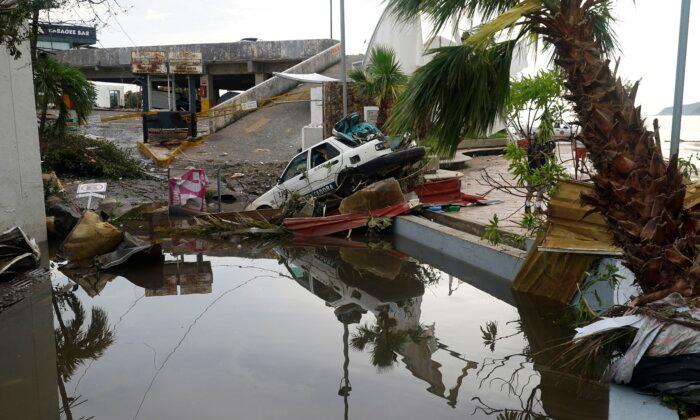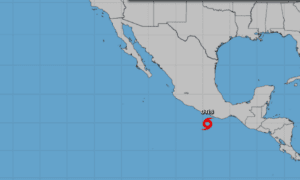ACAPULCO, Mexico—Hurricane Otis tore across Mexico’s southern Pacific coast as a powerful and dangerous Category 5 hurricane Wednesday, unleashing massive flooding in the resort city of Acapulco and setting off looting as desperate relatives tired of waiting for help to arrive.
While little is known about possible deaths or the full extent of the damage—Acapulco was still mostly inaccessible by road as of late Wednesday—experts are calling Otis the strongest storm in history to make landfall along the Eastern Pacific Coast.
Many of the once sleek beachfront hotels looked like toothless shattered hulks, after Hurricane Otis blew out hundreds—and possibly thousands—of hotel windows.
Choked with mud and debris, with no electricity or internet service, the Pacific coast resort descended into chaos after the storm, as thousands engaged in massive looting.
The hurricane had dissipated over the mountains by Wednesday afternoon, but left devastation in its wake.
Jakob Sauczuk was staying with a group of friends at a beachfront hotel when Otis hit. “We laid down on the floor and some between beds,” Mr. Sauczuk said. “We prayed a lot.”
One of his friends showed reporters photos of the windowless, shattered rooms in the hotel. It looked as if someone had put clothes, beds and furniture in a blender, leaving a shredded mess.
He complained that his group was given no warning, nor were offered safer shelter, by the hotel.
Pablo Navarro, an auto parts worker who was lodged in temporary accommodations at a beachfront hotel, thought he might die in his 13th story hotel room.
“I took shelter in the bathroom, and thankfully the door held,” said Mr. Navarro. “But there were some rooms where the wind blew out the windows and the doors.”
Mr. Navarro said authorities seemed to have been blindsided by the hurricane’s rapid intensification.
He stood Wednesday outside a discount grocery and household goods store near the hotel zone, as hundreds of people wrestled everything from packs of hot dogs and toilet paper to flat screen TVs out of the muddy store, struggling to push loaded metal shopping carts onto the mud-choked streets outside.
“This is out of control, “ he said.
Acapulco’s Diamond Zone, an oceanfront area replete with hotels, restaurants and other tourist attractions, looked to be mostly underwater in drone footage that Foro TV posted online Wednesday afternoon, with boulevards and bridges completely hidden by an enormous lake of brown water.
Large buildings had their walls and roofs partially or completely ripped off. Dislodged solar panels, cars, and debris littered the lobby of one severely damaged hotel. People wandered up to their waists in water in some areas, while on other less-flooded streets soldiers shoveled rubble and fallen palm fronds from the pavement.
While much of the city was in the dark and without phone service, some people were able to use satellite phones loaned by the Red Cross to let family members know they were OK.
Alicia Galindo, a 28-year-old stylist in the central Mexican city of San Luis Potosí, was one of the lucky ones to get such a call. Her parents and brother were staying in Acapulco’s Hotel Princess for an international mining conference when Otis hit.
They told her the worst part of the storm was between 1 a.m. and 3 a.m. when “windows began to fall, floors broke up, mattresses flew, hallways collapsed, doors fell down ... until everything was gone,” she said in a telephone interview with The Associated Press. Fortunately, they escaped unhurt, she said.
However, Ms. Galindo had yet to hear from her boyfriend, who was attending the same conference but staying in a different hotel.
“Everybody is trying to find something out ... but no one knows anything,” she said anxiously.
The main highway into Acapulco was blocked by landslides for most of Wednesday, complicating efforts to reach people and effectively cutting off the city from essential resources. By late Wednesday, the roadway had been cleared only for emergency vehicles, authorities announced.
Flor Campos trudged for more than an hour through mud along a highway outside Acapulco on Wednesday morning before she peeled off her shoes, worried she'd lose them in the muck.
The domestic worker from a small town in Guerrero was among dozens of families, women and children who clambered over tree trunks and other debris left by landslides in the mountainous terrain. It was a daunting escape, but people were desperate to get out.
“We had been waiting since 3 in the morning to get out, so we decided to walk. It was more dangerous to stay.” Ms. Campos said.
On Tuesday, Otis took many by surprise when it rapidly strengthened from a tropical storm to a powerful Category 5 as it tore along the coast.
Acapulco, Tecpan, and other towns along the Costa Grande in Guerrero were hit hard, said Mexican President Andrés Manuel López Obrador. He said conditions were so bad that communication with the area had been “completely lost.”
Acapulco is a city of nearly 1 million people at the foot of steep mountains. Luxury homes and slums alike cover the city’s hillsides with views of the glistening Pacific. Once drawing Hollywood stars for its nightlife, sport fishing and cliff diving shows, Acapulco has in more recent years fallen victim to competing organized crime groups that have sunk the city into violence, driving many international tourists to the Caribbean waters of Cancun and the Riviera Maya or beaches farther down the Pacific coast in the state of Oaxaca.
Damage to the local military airport made it hard for authorities to access the region, Mr. López Obrador said. Mexico’s Secretary of National Defense told the AP on Wednesday that 7,000 military personnel had been deployed to the area, and that over 1,200 more were on their way. Officials also said they were working to restore power and phone service.
Mr. López Obrador noted that Otis was a stronger hurricane than Pauline, which hit Acapulco in 1997, destroying swaths of the city and killing more than 300 people.







